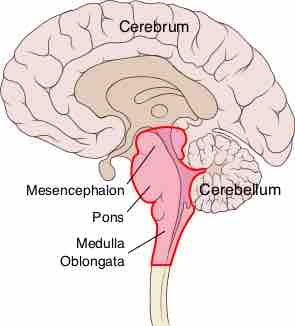Involuntary respiration is any form of respiratory control that is not under direct, conscious control. Breathing is required to sustain life, so involuntary respiration allows it to happen when voluntary respiration is not possible, such as during sleep. Involuntary respiration also has metabolic functions that work even when a person is conscious.
The Respiratory Centers
Involuntary respiration is controlled by the respiratory centers of the upper brainstem (sometimes termed the lower brain, along with the cerebellum). This region of the brain controls many involuntary and metabolic functions besides the respiratory system, including certain aspects of cardiovascular function and involuntary muscle movements (in the cerebellum).
The respiratory centers contain chemoreceptors that detect pH levels in the blood and send signals to the respiratory centers of the brain to adjust the ventilation rate to change acidity by increasing or decreasing the removal of carbon dioxide (since carbon dioxide is linked to higher levels of hydrogen ions in blood).
There are also peripheral chemoreceptors in other blood vessels that perform this function as well, which include the aortic and carotid bodies.

Anatomy of the brainstem
The brainstem, which includes the pons and medulla.
The Medulla
The medulla oblongata is the primary respiratory control center. Its main function is to send signals to the muscles that control respiration to cause breathing to occur. There are two regions in the medulla that control respiration:
- The ventral respiratory group stimulates expiratory movements.
- The dorsal respiratory group stimulates inspiratory movements.
The medulla also controls the reflexes for nonrespiratory air movements, such as coughing and sneezing reflexes, as well as other reflexes, like swallowing and vomiting.
The Pons
The pons is the other respiratory center and is located underneath the medulla. Its main function is to control the rate or speed of involuntary respiration. It has two main functional regions that perform this role:
- The apneustic center sends signals for inspiration for long and deep breaths. It controls the intensity of breathing and is inhibited by the stretch receptors of the pulmonary muscles at maximum depth of inspiration, or by signals from the pnuemotaxic center. It increases tidal volume.
- The pnuemotaxic center sends signals to inhibit inspiration that allows it to finely control the respiratory rate. Its signals limit the activity of the phrenic nerve and inhibits the signals of the apneustic center. It decreases tidal volume.
The apneustic and pnuemotaxic centers work against each other together to control the respiratory rate.